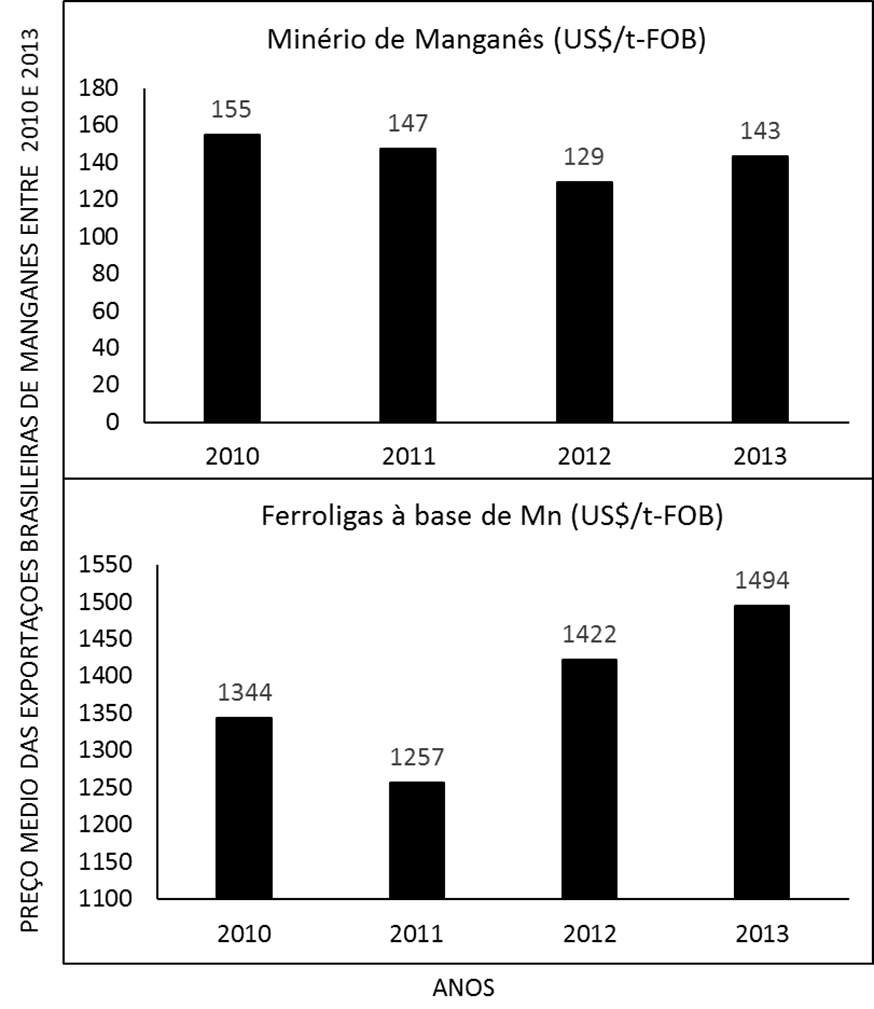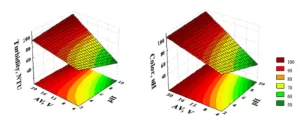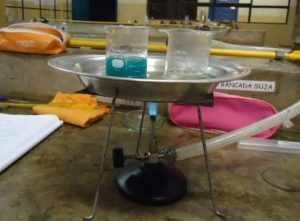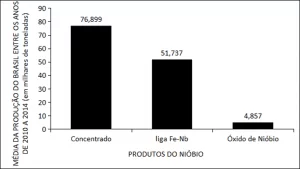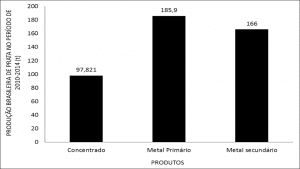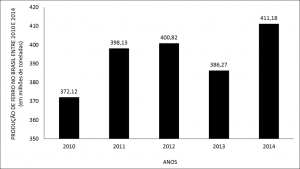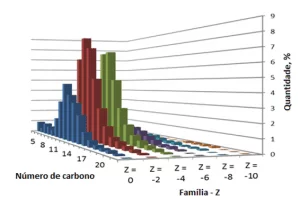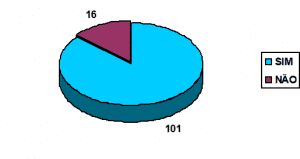TORRES, Carine Correa [1], ARAÚJO, Franciolli da Silva Dantas [2], FECURY, Amanda Alves [3], OLIVEIRA, Euzébio [4], DENDASCK, Carla Viana [5], DIAS, Claudio Alberto Gellis de Mattos [6]
TORRES, Carine Correa. Et al. Brazilian manganese reserve, production, market and consumption between 2010 and 2013. Revista Científica Multidisciplinar Núcleo do Conhecimento. Year 03, Ed. 09, Vol. 08, pp. 63-73 September 2018. ISSN:2448-0959, Acess Link: https://www.nucleodoconhecimento.com.br/quimica-en/brazilian-manganese, DOI: 10.32749/nucleodoconhecimento.com.br/quimica-en/brazilian-manganese
SUMMARY
Usually found in solid state, manganese (Mn) is a metallic substance, is one of the most abundant elements of the earth’s crust, being associated with other elements, forming various types of minerals, but there are few that make up the minerals of manganese ore. The extraction, or mining, of manganese ore can be carried out by the open pit method with the use of mechanical excavators, rippesr, draglines, or other equipment, without the use of explosives. The reservations discussed in the article refer to the washable reserves officially approved by the National Department of Mineral Production, disregarding those under the license, extraction and permission of mining. The research was carried out in mineral summaries published by the National Department of Mineral Production – DNPM, the data were taken from the summaries and compiled in the Excel program of the Office package of Microsoft Corporatoion, for further analysis. Scientific articles from the Google Scholar, Scielo, and Periodicos Capes databases were used. It was observed that manganese production is closely related to the consumer market, decreasing or increasing according to its need. What can influence the maintenance of Brazil in a privileged position among the main manganese producers in the world, are its reserves. Because these are large and high-content reserves in Brazil, the exploitation of manganese ore becomes economically viable, increasing production, in view of the demand of the domestic and foreign consumer market. The states that hold the majority of production are Pará (70%), Minas Gerais (15%) and Mato Grosso do Sul (14.6%). Given the results presented, it is understood that Brazil has enough potential to be in a more advantageous position among the main manganese producers in the world, due to the reserves it has. Despite having considerable quantities, Brazil still has to invest in research that points to new reserves to be mined, so that Brazilian production meets the growing demand of the consumer market, especially when it refers to the export of its products, since its increase provides advantages to the country.
keywords: Manganese, Brazilian production, Reserve, Demand.
INTRODUCTION
Usually found in solid state, manganese (Mn) is a metallic substance with a specific mass ranging from 7.21 g/cm³ to 7.40 g/cm³ (Santana, 2009). It is one of the most abundant elements of the earth’s crust, being associated with other elements, forming various types of minerals, but there are few that make up the minerals of manganese ore. Its main minerals are braunite, cryptomelaone, hausmannite, jacobsite manganite, nsutite, psilomela, pyrolusite, rhodocrosita, rhodononite and todorokite (Sampaio, Andrade, Dutra & Penna, 2008). It has a high degree of hardness, although brittle and brittle, presenting as dark and shiny gray metal (ROCHA and AFONSO, 2012).
As for its use, manganese is present in the manufacture of paints, staining and discoloration of glass, in the ceramics industry, chemical reagents, in the production of fertilizers, used in agriculture as soil brokers and in water treatment and air pollution control (SAMPAIO et al., 2008; ANGELI et al., 2011). Manganese is widely used in the manufacture of metal alloys, but currently has been widely used in the production of electric car battery (BARBOSA et al., 2017).
Mineral is every chemical element or compound of natural occurrence, originating from geological, physical-chemical and inorganic processes, which has crystalline structure (arrangement of atoms) and well-defined chemical composition. Ore can be said as a rocky body composed of one or more minerals that can be harnessed economically. Ore minerals, in turn, are minerals that can be extracted with economic viability, that is, they are those of economic interest (BRASIL, 2017).
Manganese formation occurs with the origin of protoores in marine sedimentary environments or depressions formed by water, due to deposition of disaggregated grains of preexisting rocks and the formation of minerals in the face of chemical processes, in view of changes in the crystalline arrangement of other minerals, forming new deposits of manganese (CETEM, 2007). It is found in large amounts in the sea in the form of nodules, which are mineral concentrations formed at the bottom of the oceans, but their reserves are located mainly in sedimentary deposits, considered of great importance, since they exist all over the world and some have very high levels of manganese, being of estimated economic interest (SAMPAIO et al., 2008).
Mining can be understood as the extraction of ores from the earth’s crust through processing processes so that there is the release of minerals (DNPM, 2017). ). The extraction, or mining, of manganese ore can be carried out by the open pit method with the use of mechanical excavators, rippesr, draglines, or other equipment, without the use of explosives, in addition to using off-road trucks for the transport of ore. The processing of the ore depends on the process chosen by the mining company, however, in general, manganese passes first through a grid for the removal of organic waste or other materials, then passes through the crusher and then by atrition in blind tromesis or gravel washers, for the removal of the clay fraction, if necessary passes through rotating or vibrating sieves (SAMPAIO et al. , 2008).
Amapá was responsible for much of the Brazilian manganese production and export between 1957 and 1986 (DRUMMOND, 2004). It was seen as the main producer of the country, however, with the closure of its deposits, it was replaced by the state of Mato Grosso. Currently Brazil is one of the main manganese producing countries in the world (BRASIL, 2015). ). The manganese production mentioned here refers to the production benefited (DNPM, 2014).
The earth’s crust has a large amount of mineral resources, which are concentrations of ore to which economic value can be attributed and which undergo studies that evaluate characteristics such as content, quantity, quality and location. The part of the mineral resource that can be extracted with economic viability is the reserve, considering the amount of ore and the mineral content of interest (BRASIL, 2016). The reserves discussed here refer to the washable reserves officially approved by the National Department of Mineral Production, disregarding those under the license, extraction and permission of mining mining (DNPM, 2014)
The apparent consumption of manganese refers to the domestic demand of Brazil, where the production plus import is added and subtracted the export of manganese (DNPM, 2014). ). The export is given at the FOB price meaning Free On Board, that is, the exporter is responsible for the material that is exporting until it is shipped (BRASIL, 2006).
GOAL
Show the world production and reserve and the national panorama of manganese between 2010 and 2013.
METHOD
Research carried out in mineral summaries published by the National Department of Mineral Production – DNPM (http://www.dnpm.gov.br/), according to the following steps: the main menu was accessed by the “Publications” bar; then, on the page that opened, it was clicked on “Statistical Series and Mineral Economy”. On the next page you have selected “Mineral Summary”. Next, the “Brazilian Mineral Summary” was downloaded from 2011 to 2015. The data was taken from the summaries and compiled in the Excel program of the Microsoft Corporatoion Office suite for further analysis. Scientific articles from Google Scholar (https://scholar.google.com.br/), Scielo (http://www.scielo.org/), and Periodicos Capes (http://www-periodicos-capes-gov-br.ez275.periodicos.capes.gov.br/) were used. The bibliographic research was carried out using computers from the computer laboratory of the Federal Institute of Education, Science and Technology of Amapá, Macapá Campus, located at: Rodovia BR 210 KM 3, s/n – Bairro Brasil Novo. ZIP Code: 68.909-398, Macapá, Amapá, Brazil.
RESULT
Figure 1 shows the average manganese production, in millions of tons (106t) of the world’s leading producers, from 2010 to 2013. In this period, Brazil was the fifth largest producer of manganese, when compared to the other countries.
Figure 1: Production of the world’s leading manganese producers between 2009 and 2013 in millions of tonnes (Mt)
Figure 2 shows the average manganese reserves (106t) of the world’s leading reserve countries between 2010 and 2013. Brazil has the fifth largest manganese reserve among the seven countries mentioned.
Figure 2: Average manganese reserves (106t) between 2010 and 2013, by country.
Figure 3 shows the average of Brazilian manganese products between 2010 and 2013 (106 t). 2010 was the year that produced the most manganese concentrate, followed by a fall in 2011 remaining approximate in the other years. Although the metal production contained in manganese concentrate decreased in 2011 compared to 2010, it did not suffer from high variations during the period 2010 and 2013. In 2011, there was a fall in the production of manganese-based ferroalloys when compared to 2010, followed by an increase in later years.
 Figure 3: Shows the average of Brazilian manganese products between 2010 and 2013 (106 t).
Figure 3: Shows the average of Brazilian manganese products between 2010 and 2013 (106 t).
Figure 4 shows the total import and export of manganese in Brazil between 2010 and 2013 (103t). The amount of manganese concentrate exported is greater than the amount of concentrate that is imported. The export and import of semi-manufactured goods remained close, however, with greater exportation.
Figure 4: Shows the total import and export of manganese in Brazil between 2010 and 2013 (103t).
Figure 5 shows the apparent consumption of manganese concentrate in Brazil between 2010 and 2013 (103t). In 2011 there was a decrease in concentrate consumption, but in 2012 this number rose almost double, followed by a further decrease the following year.

Figure 5: Shows the apparent consumption of manganese concentrate in Brazil between 2010 and 2013 (103t).
Figure 6 shows the average price of Brazilian manganese exports between 2010 and 2013. From 2010 to 2012, there was a degrowth in the average price of manganese ore exports and in 2013 this price increased. The average price of manganese-based ferroalloys decreased until 2011, rising again in the following years.
Figure 6: Shows the average price of Brazilian manganese exports between 2010 and 2013.
DISCUSSION
Manganese production is closely related to the consumer market, decreasing or increasing according to its need. What can influence the maintenance of Brazil in a privileged position among the main manganese producers in the world, are its reserves, and they can be low or high content, it is considered that those with higher content are rare and few are the countries that hold them. Because these are large and high-content reserves in Brazil, the exploitation of manganese ore becomes economically viable, increasing production, in view of the demand of the domestic and foreign consumer market (MME, 2009). In Brazil, the states that own the majority of production are Pará with 70%, Minas Gerais with 15% and Mato Grosso do Sul with 14.6% of production (CNQ, 2015).
Adding the world’s all-world reserves of manganese, including those of low content and quality, it is estimated that they reach billions of tons, however, if only those of high content (above 44%) are computed, this value does not exceed 1 billion tons of ore. Such reserves can be found mainly in southern hemisphere countries such as South Africa, Australia, Gabon and Brazil (IMnI, 2017). The main Brazilian reserves are located in the states of Minas Gerais, Mato Grosso do Sul, Bahia and Pará (MME, 2009).
When comparing figures 1 and 2, it is verified that some countries even holding smaller reserves, when compared to the other ones, are large producers. This may be due to high-content reserves (above 44% manganese) or because they are countries that consume most of what it produces as is the case of China, which has smaller and low-content reserves, but is one of the main responsible for the consumption of global metals (DNPM, 2014; IMNI, 2017)
The reduction in production of manganese concentrate, contained metal and manganese-based ferroalloys in 2011 may have occurred due to a decrease in growth rates in China, the world’s leading consumer. In the following years there were reasonable growthin the production of the same products, and can be explained by the improvement in consumer market demand or, furthermore, the release of concessions for the opening and operation of new mines, to meet the demand for ore (DNPM, 2014)
When analyzing Figure 4, it can be observed that the Brazilian trade balance is favorable in relation to manganese, since there are more exports and fewer imports. But the quantities of imported manganese and semi-manufactured concentrate is still very large, this may occur due to a better quality in the imported manganese content or other advantages that manganese from countries on the Atlantic coast of Africa, such as South Africa and Gabon, can offer compared to manganese produced in northern Brazil, but without devaluing manganese produced in the country (MME , 2009).
The apparent consumption of manganese concentrate was very uneven over the period from 2010 to 2013. The decreases in consumption may have occurred due to the increase in exports, without there being increases in imports, and the increases in domestic consumption of concentrates may have occurred due to the decrease in exports, along with a small increase in Brazilian national production (DNPM, 2013; 2014)
The decreases identified in the average price of Brazilian exports may have been caused by the devaluation of manganese ore in 2011, and ferroalloys based on this element, in the international market, as well as the increases in price may have occurred due to the appreciation of ore in 2012 (it is also noted, also the devaluation of ore in 2013)
CONCLUSION
Brazil has enough potential to be in a more advantageous position among the main manganese producers in the world, due to the reserves it has (wide and with high content of the element). Despite having considerable quantities, Brazil still has to invest in research that points to new reserves to be mined, so that Brazilian production meets the growing demand of the consumer market, especially when it refers to the export of its products, since its increase provides advantages to the country.
REFERENCES
ANGELI, N. et al. Geologia e Caracterização Tecnológica do Minério de Manganês da Mina Córrego do Cocho, Itapira (SP). Geologia USP, v. 11, n. 3, p. 107-130, 2011.
BARBOSA, G. F. A. et al. Levantamento Histórico de Processos Minerários de Manganês no Estado do Amapá. XXVII Encontro Nacional de Tratamento de Minérios e Metalurgia Extrativa (ENTMME). Belém PA: IFPA 2017.
BRASIL. O que é? FOB. 2006. Disponível em: < http://desafios.ipea.gov.br/index.php?option=com_content&view=article&id=2115:catid=28&Itemid=23 >. Acesso em: 20 de dezembro de 2017.
______. RMB – Recursos Minerais do Brasil. Manganês (Mn). 2015. Disponível em: < http://www.rmb.com.br/site3/manganes-mn >. Acesso em: 11 de dezembro de 2017.
______. Guia CBRR para declaração de resultados de exploração, recursos e reservas minerais. Brasília: CBRR – Comissão Brasileira de Recurso e Reservas 2016.
______. Glossário Geológico Ilustrado. 2017. Disponível em: < http://sigep.cprm.gov.br/glossario/index.html >. Acesso em: 04 de dezembro de 2017.
CETEM. Disponibilidade, suprimento e demanda de minérios para a metalurgia. Rio de Janeiro: Centro de Tecnologia Mineral CETEM/MCT 2007.
CNQ. O Setor Mineral. São Paulo: Confederação Nacional do Ramo Químico CNQ-CUT 2015.
DNPM. Sumário Mineral 2013. Brasília: Departamento Nacional de Produção Mineral DNPM 2013.
______. Sumário Mineral 2014. Brasília: Departamento Nacional de Produção Mineral DNPM 2014.
______. Glossário Geológico – Mineração. 2017. Disponível em: < http://www.dnpm-pe.gov.br/Geologia/Mineracao.php >. Acesso em: 20 de dezembro de 2017.
DRUMMOND, J. A. O manganês do Amapá – o seu papel no desenvolvimento regional e nacional (1957-1998). II Encontro Nacional da Associação Nacional de Pós Graduação E Pesquisa em Ambiente e Sociedade ANPPAS. Indaiatuba SP 2004.
IMNI. Reserva. 2017. Disponível em: < http://cn.manganese.org/about-mn/reserves >. Acesso em: 20 de dezembro de 2017.
MME. Perfil da Mineração de Manganês, Relatório 19., 2009. Disponível em: < http://www.mme.gov.br/documents/1138775/1256650/P11_RT19_Perfil_da_mineraxo_de_manganxs.pdf >. Acesso em: 20 de dezembro de 2017.
ROCHA, R. A.; AFONSO, J. C. Manganês. Química Nova na Escola, v. 34, n. 2, p. 103-105, 2012.
SAMPAIO, J. A. et al. Manganês. In: A. B. LUZ &, F. A. F. L. (Ed.). Rochas & Minerais Industriais. Rio de Janeiro: CETEM/MCT, 2008. p.633-648.
[1] High school student. Technical Course in Mining. Federal Institute of Basic, Technical and Technological Education of Amapá (IFAP).
[2] Materials Technologist. Master in Materials Science and Engineering. Researcher Professor, Federal Institute of Basic, Technical and Technological Education of Amapá (IFAP)
[3]Biomedical. PhD in Tropical Diseases. Researcher Professor, Federal University of Amapá (UNIFAP).Biologist. Doctor of Tropical Diseases. Researcher Professor at the Federal University of Pará (UFPA).
[4] Biologist. Doctor of Tropical Diseases. Researcher Professor at the Federal University of Pará (UFPA).
[5] Theologian. PhD in Clinical Psychoanalysis. Researcher at the Center for Research and Advanced Studies, São Paulo, SP.
[6] Biologist. PhD in Theory and Behavior Research. Researcher Professor, Federal Institute of Basic, Technical and Technological Education of Amapá (IFAP)



